The Pacific Madrone (Arbutus menziesii) is perhaps our second most favorite tree growing here (second only to our Coast Redwoods). Recently, however, we’ve realized our Pacific Madrones are likely the most at risk of disappearing from Curbstone Valley, permanently.
Arbutus menziesii is native to the Pacific coast, ranging from British Columbia, southward to California’s central coast. This species becomes less common south of Santa Barbara county, but isolated stands can be found as far south as Baja Mexico.
Arbutus, from Latin, means strawberry tree, and was named such by naturalist Archibald Menzies for its red strawberry-like fruits.
The Pacific Madrone is renowned for its crooked beauty. This evergreen tree produces masses of creamy white flowers in the spring, later followed in autumn and winter by a profusion of red berries. The exfoliating bark in summer is a rich orange-to-red color, often peeling in large sheets.
The leaves are thick, oval, 7-15 cm long and 4-8 cm broad, and arranged spirally; they are glossy dark green above and a lighter, gray-green beneath.
The flowers are relished by bees, and the berries are favored by birds, especially quail, band-tailed pigeons, and dark-eyed Juncos, of which we have very large populations residing here all year – one of whom loves to admire himself in the side-view mirror of my truck, for hours at a time! Deer favor young shoot and seedling growth, and as this species is prone to heart rot with age, other wild creatures find shelter in the cavities produced within mature trees.
Native peoples had varied uses for Arbutus menziesii. The Cowichan and Pomo used an infusion of the bark to treat small wounds and sores, and chewed the leaves to treat sore throats. The Miwok made a cider that was used to treat stomach ailments, and as an appetite stimulant. A number of tribes used the berries as food, either raw in small quantities, or they were steamed, dried, and stored for later use. [1]
Arbutus menziesii however has been known to be in decline throughout its range since the late 1960s. [2]
Pacific Madrones are frequently found in association with Douglas Fir, Tanbark Oak, and Redwood, all of which are present on this property. Our Madrones, however, are primarily restricted to a southern slope above one of the creeks, with a few scattered specimens along the west-facing slope near the main house. It’s clear that of the few remaining Madrones still growing here that few, if any, could be considered healthy.
In the last year alone at least four substantial trees have fallen on the south slope, and at least three others can be seen standing, but are clearly dead, completely defoliated. Of the those that remain, only three have been seen with healthy green canopies, and producing fruit, although they can be difficult to find amidst the over-story growth, as they tend to lean and stretch outward, growing through bay laurels, or oaks, as they reach for light.
As our Madrones clearly aren’t thriving, we wanted to try to find out why. Until we know what’s killing them, how can we preserve them? However, the problem clearly is not a simple one. Apparently there are more than 21 known species of fungus that are associated with disease in Pacific Madrones, although the two most prevalent are reported to be the Arbutus Canker (Nattrassia mangiferae) and Madrone Canker (Fusicoccum aesculi). Another important culprit is a root rot in mature Madrone trees caused by the fungus Phytophthora cactorum (a fungus in the same genus as Sudden Oak Death).
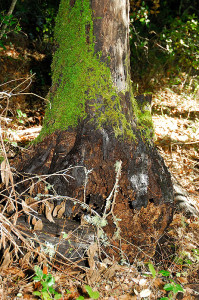
Dead for some time, the roots of this Madrone are gone, although the rest of the trunk wood is still sound
However, Madrones are also susceptible to Phytophthora ramorum, the causative agent of Sudden Oak Death. Symptoms of a number of fungal diseases that afflict Pacific Madrones often appear first in the canopy of trees, often beginning at the branch tips, and severe disease can result in die-back of entire branches, ultimately killing the tree. Unfortunately, infection with Fusicoccum or Phytophthora, without laboratory testing, can be virtually impossible to differentiate, as their observable symptoms overlap.
Arbutus menziesii naturally favors growing in dry soils, and in cultivation supplemental irrigation and fertilizer both contribute initially to lush growth, but result in a shortened lifespan. This is not a good candidate for a lawn or garden tree primarily for that reason. The Madrones growing here though are in undisturbed naturally forested areas.
However, Pacific Madrone depends on periodic fire to eliminate or at least significantly reduce the conifer over-story, which enhances both light and air circulation in the understory, permitting Madrones to thrive. Fires that result in repeated top-kill of Madrones will encourage burl development in these trees, which in turn enhances Pacific Madrone survival, as the burls nutritionally sustain root-crown sprout growth after fire. Oak-Pacific Madrone-Douglas-fir and Redwood forests, where Pacific Madrone naturally occurs, historically experienced understory fires at intervals between 5 and 25 years.
The last significant fires in this area though were probably those associated with Redwood logging activities in this region more than a century ago. Most importantly, as with many California native plant species, fire favors Pacific Madrone seedling establishment. [3]
Ironically, in areas managed for conifer timber production today, the Pacific Madrone is considered a “weedy” tree species, because it out-competes replanting of timber species due to its ability to resprout from its burls after disturbance. [4]
So it seems a combination of numerous and pervasive pathogenic fungal diseases, coupled with a century of fire suppression, are at least partially to blame for the decline of Pacific Madrone in this area.
Speaking of seedlings, therein lies our other observation. Of the trees that have fallen here, and even below the more healthy Madrone specimens still growing here, despite abundant fruit-set each year, we’ve found absolutely no seedling Madrones in the understory growing as replacements. None. In fact, the only ‘small’ Madrone we’ve observed here thus far, is this rather sad (and dead) looking ‘Charlie Brown’ specimen near one of the southwestern oriented mountain ridges in the center of the property.

Although now dead, this young Madrone exhibited the classic crooked and contorted architecture this species is known for
It seems clear, here at least, the rate of Pacific Madrone loss is far outpacing the rate of replacement, and with so few Madrones left on this property, we’re wondering how much longer they will continue to grow here.
Apparently Madrone seedling germination rates in the wild are very high (close to 90 percent), not that we’ve ever once seen a seedling in the three years we’ve been here. So where are they? The caveat is that mortality of Madrone seedlings is also very high, reportedly between 90-100 percent! That at least helps to explain why we’re seeing little in the way of understory replacement of Madrones here.
Seedlings are commonly killed by a variety of factors, including drought, fungi associated with damping-off, root rot, desiccation during early growth before the seedlings are established, smothering by deep leaf litter, frost heaving, and predation by slugs, and of course our ever-ravenous deer. [5]
Further digging in the literature revealed that soil disturbance actually favors seedling establishment. Seedlings and young trees however with their fragile root systems, once sprouted, resent disturbance and are often killed by it. Studies have shown that seedling establishment is poor in areas with low light, heavy litter-fall, damping-off fungi, and predation on the forest floor. So it seems, looking critically at where our Pacific Madrones have previously grown, in the absence of fire, and the presence of increasingly dense forest canopies, the conditions that once favored their growth are no longer present in those areas. Barring a catastrophic alteration of our forest canopies, our ‘hands off’ approach to restoration (except for invasives) could cause the Pacific Madrones growing here to soon disappear. Perhaps it’s time to reconsider that approach.
It seems clear that trying to re-establish new Madrones where they’ve been growing previously, will likely doom them to failure as the canopies of Douglas Fir and Redwood are too thick, and the litter on the forest floor too deep, and too damp to enable their survival. Careful forest management, under professional guidance, may be necessary to help maintain suitable growing conditions where our Madrones once grew.
However, last year we removed a number of dead trees, and did open up an area where the orchard and gardens were installed. Up-slope of this area is drier, and brighter along the south-facing slope, devoid of routine supplemental irrigation, and now protected from deer by the perimeter fencing. Two somewhat healthier Madrones are growing just outside the fence perimeter up-slope, so this may be our best area at the moment to attempt to establish some young trees, just inside the fence line away from browsing deer.
Although we could source Pacific Madrones that have been nursery propagated as replacement trees, we’d prefer to try propagating them ourselves. If we’re successful, we’d expect that plants produced from seed endemic to the property would likely be better adapted to the growing conditions here than a tree sprouted in a nursery in Oregon or Washington.
The Madrone berries have been abundant this fall, and we should have enough seed to engage in a little trial-and-error survival-of-the-fittest experimental gardening. I’ve collected some recently fallen berries during my walks around the property, and now need to separate the seed from the fruit, and cold stratify the seeds for 60 days. At that point the seeds can be sown into a sandy medium, and hopefully at least some will sprout. For more regarding propagation of this species see this article. The reality is, at the rate we’re losing these beloved trees, we have little to lose.
Although we’d love to see many more of these trees growing here, for now we’ll be happy if we can succeed in establishing just a few healthy specimens on the property. It’s going to require a long-term multi-factorial approach, but for now I’m crossing my fingers they’ll sprout, and that by next November we’ll have some young Pacific Madrones ready to transplant back into the woods. We’ll let you know how that project transpires along the way…
MADRONO
“Where, O where, shall he begin
Who would paint thee, Harlequin?
With thy waxen burnished leaf,
With the branches’ red relief,
With the poly-tinted fruit,
in thy spring or autumn suit, —
Where begin, and O, where end, —
Thou whose charms all art transcend?”
~ Bret Harte
————-
[1] Daniel E. Moerman’s Native American Ethnobotanical Database
[2] Farr DF, Elliott M, Rossman AY, Edmonds RL 2005. Fusicoccum arbuti sp. nov. causing cankers on pacific madrone in western North America with notes on Fusicoccum dimidiatum, the correct name for Scytalidium dimidiatum and Nattrassia mangiferae. Mycologia 2005 May-Jun; 97(3): 730-41
[3] USDA Forest Service: Fire Effects Information System (FEIS)
[4] USDA Natural Resources Conservation Service
[5] Tappeiner, John C., II; McDonald, Philip M.; Hughes, Thomas F. 1986. Survival of tanoak (Lithocarpus densiflorus) and Pacific madrone (Arbutus menziesii) seedlings in forests of southwestern Oregon. New Forests. 1: 43-55.




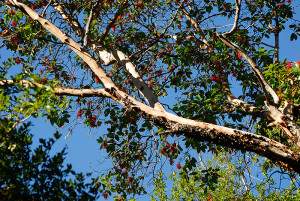
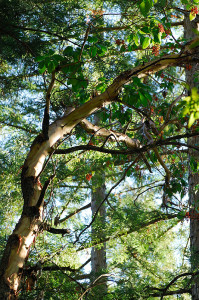
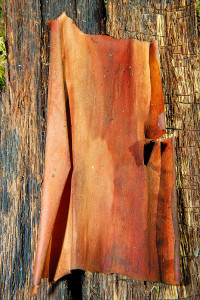

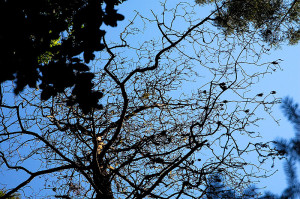
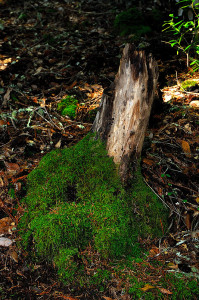
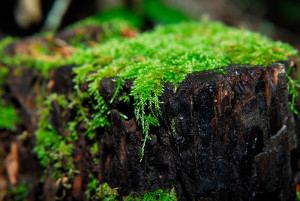

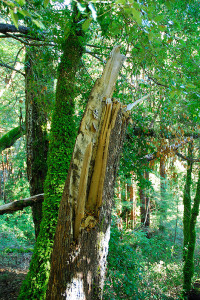

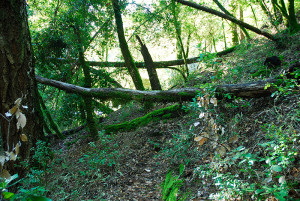

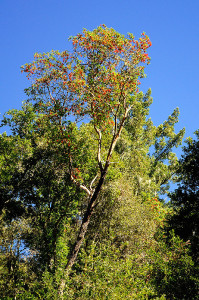
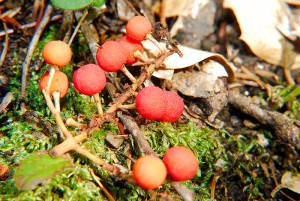
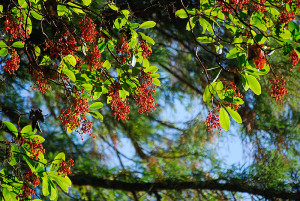







You raise such an interesting issue: native vegetation naturally changes- sounds like you’re going from an Oak Woodland to Redwood Forest. Typically a fire will knock out the redwoods and it starts over again as Chapparal or Grassland. With human interaction, that just isn’t likely. (I hope so, anyway for your sake!) I wish you the best of luck in makin’ Madrone babies- they really are magnificent trees.
Hopefully we can establish one or two in the more disturbed, sunnier locations. You’re right though, forests do change. That’s why I’m not a purist restoration gardener…I wouldn’t know which set-point to restore to! 😉 I suppose this is the way it should be though. Madrones move in first, stabilize the soils, and then they give way to the second growth species as the woodland recovers.
I never heard of the madrone. I was glad to read about them here. This is really an interesting tree. The fruit is stunning in red. It is sad that over 90 percent of seedlings succumb. Good luck in your propagation efforts.
I hope you get to see one in person some day. Not one of our spindly specimens, but a robust healthy tree. They really are beautiful.
As I began reading your post, I was thinking what a great tree with four season appeal. How sad that the tree is in decline. I hope you and others are able to propagate and establish more healthy madrone trees.
We have at least 2 species here in the tropics which have berries and habits like what you posted. One we now make wines from and the other one not yet studied. I am with you in preserving native species. We also have bad cases of Phytophthora in fruit trees, just like avocado, durian, cacao and many more. In our property we lost cacao plants, avocado and citrus trees. However, we just let nature take its course, anyway we are not really counting on its production anymore.
Fantastic post of a beautiful tree.
What an excellent excellent article. Having lived in BC I was fully aware that arbutus were declining but I had not heard the reasons why. You’ve done such a good job of researching these trees, I hope it pays off and you’ll have luck with your seeds.
Wow… nice references list! Thanks for taking that extra time. You’re amazing at photo journalism. We have an arbutus tree in one of our downtown parks and I’m always puzzled by the fruits it drops. I’m not sure if it is the same species, I don’t think it is native (or at the very least common) around here, though.
It reminds me of the eastern hemlock problems we’re having here. I think scientists are finding isolated areas to grow stands of hemlocks from cones collected in Appalachian forests. The idea is that if all the local ones die out, the wooly adelgids will also die, and then they can move the species back. In the meantime we have grandfather-sized specimens that look like Charlie Brown trees.
I hope someone comes up with a way to save the native ones in your area!
Awesome post! We recently planted a Madrone in our front yard in the hopes that once it’s established we won’t have to water it and we can harvest the fruit.
I wonder if fire also helped control fungus rot of both Madrones and Oaks and because of fire suppression we’re now seeing more deaths because of it?
I’ve read a lot of articles the last few days regarding the effects of fire suppression in California. There’s a lot of discussion at the moment regarding Phytophthora, and some scientists believe it’s been in California all the time (not introduced on ornamentals from Asia), but in the absence of natural fires and controlled burns, we’ve tipped the balance, giving the fungus an opportunity to gain a stranglehold, especially on our native oaks. It seems there’s a very likely connection there. I don’t want to go up in smoke, but fire historically was an important part of our native California ecology. I hope your Madrone does well!
Dear Clare, What a detailed account you give here of this very splendid tree. The bark of the Arbutus is so tactile and its dynamic form make it a splendid specimen tree. But, how sad that your native trees are dying out. This is always sad to witness even though one understands that native habitats do change constantly.
They do change. It’s us humans that are often resistant to it. Perhaps I should look at it as gaining Redwoods, rather than losing Madrone. It does seem though that aside from natural shifts in the forest ecosystem, there’s something somewhat more sinister going on at its core.
You write so beautifully that I often feel like I personally know your subjects~and now I am close personal friends with this tree! I so hope you are successful in getting healthy growing trees in you madrone orchard! gail
Thank you Gail. These really are special trees, and honestly, I’d trade a hundred of our scraggy native Bay Laurels for just a few healthy Madrones 🙂
That looks like a beautiful tree. How sad that it is disappearing. I live in a natural fire location as well. There are some areas here that have control burns every few years, for the health of the plant species. I agree that you should take a more hands-on approach to replacing this native species.
There are fewer and fewer places here it seems that do controlled burns anymore. Obviously it’s embarrassing if one gets out of control, but there tend to be a lot of complaints when controlled burns affect air quality, even very slightly. Honestly though, with the size of some of the wildfires here in the last couple of years, I’d rather see more smaller controlled burns through the season, than a 7000 acre wildfire!
Sweet Jesus, I hope I never get Sudden Oak Death. Sounds terrible.
Turling, I agree, it is terrible. Just don’t plant yourself downhill from a native California Bay Laurel (Umbellularia californica), which seems to be the ‘Typhoid Mary’ carrier of the disease, and don’t stand still too long, and you should be fine! 😛
My mother in-law talks about her Madrone tree all the time but I do not pay much attention to the tree whenever I visit her house. Too distracted I guess. Now with the information here, I will be able to talk with her more intelligently. 🙂
Yeah, Madrone are tricky. I bought a 1 gallon pot 2 years ago, and it’s been a struggle (for the little tree, not for me). This late summer we have an attack of some fungus, last summer it looked more like thrips. We’ll just have to wait and see — but they’re so worth it! Good luck!
I knew nothing about the Pacific madrone. Thank you for sharing the beauty of this tree. I hope your re-introduction efforts are successful. Carolyn
Clare, You have outdone yourself with these outstanding photographs. Your rich story is a sad one. What a wonderful tree and how sad to be losing them on your land. Amazing post as per usual.
Dear Clare
what an outstanding post; in-depth research and so beautifully illustrated. It does raise some important ecologocial issues of preservation versus evolution but in the words of Dylan “You must do what you think you should do”. Look forward to hearing how your crooked beauties sprout
Laura
What an excellent post! I’m SO impressed!! I’m sharing this on FB as I’m sure others will love reading all about the mighty madrone.
Hello Clare
I’ve just seen a mature tree with those wonderful fruits once in a botanical garden and I admired those wonderful shaped fruits. I can understand why you want to help to preserve those beauties on your land. They are such majestic looking trees. I wish you lots of success and look forward to reading how it things progress.
I can see why you love these trees. I do love trees that produce red berries during the winter. I am interested in seeing if your efforts in growing them from your own seed in the more open area of your landscape works. I do hope that it does 🙂
I’ve always loved Madrones as they so closely resemble Manzanitas, which are my absolute favorite of all of our natives. I’ve tried planting a couple Madrones on our property before (one-gallon plants), but they never took and I’m sure it was due to a combo of climate and placement. Based on your article (fantastic, by the way, for so much in-depth info), it seems that Madrones thrive in forested areas. Although we are at a 2,000 ft. elevation, it’s pretty typical Southern California chaparral we have down here, so clearly not primo habitat for the Madrones. Anyways, I look forward to seeing how your Madrone restoration project goes!
Once again I thank you for your careful research and your easy-to-follow information. The images illustrate your text beautifully. Your blog is a goldmine of information. Your time and effort in maintaining it–one way to change the world for the better. Thank you again, from the bottom of my heart.
Bad news, what a bummer! I remember first falling in love with these sinewy natives as they graced the edges of the redwoods above the UCSC campus. Super informative post — I haven’t paid attention to this problem yet but will start trying to assess the health of any trailside madrones I’m lucky enough to come across. Thanks for the info!